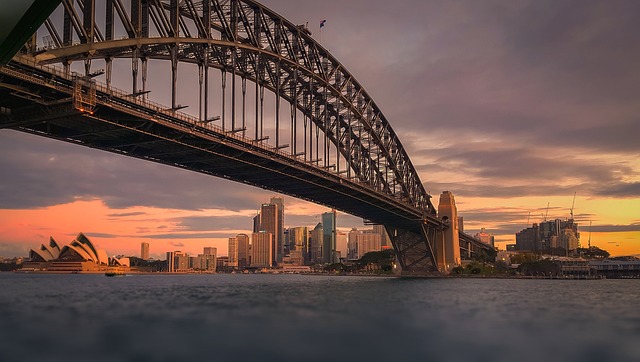It is a half-through arch bridge that connects the North Shore with Sydney central business district (CBD). Due to its unique design, it is often referred to as ‘The Coathanger’. The design of this bridge was conceived by Dorman Long and Co Ltd, a British firm based in Middlesbrough. On the opening parties of the bridge, almost one million people joined in to mark the celebration. At the time, the population of Sydney was 1.256 million. In order to lessen the burden of traffic on this bridge, the Sydney Harbor Tunnel was built and completed in 1992. It was constructed for the vehicles only.
History
- In 1815, the idea of constructing a bridge connecting north to the south was proposed by English-born architect Francis Greenway.
- In 1840, another architect named Robert Brindley suggested for building a floating bridge.
- About 1857, Peter Henderson was one of the first individuals to draw the bridge across Sydney harbor on paper.
- In 1879, an idea for building a truss bridge was proposed.
- At the north shore, 469 buildings had to be demolished for the bridge. No compensation was paid to those people.
- The two sections of the arch met each other within less than two years in 1930. This event was marked by flying the flags of U.K. and Australia on 20 August.
- In 1931, the connections for the power lines, water and drainage system were installed to this bridge.
- On 15 January 1932, the last stone of the pylon at north-west was installed.
- The first steam locomotive crossed the Harbour Bridge on 19 January, 1932.
- During the construction of the bridge, sixteen labors died. Out of these, two workers died while going down from the bridge.
- It was completed at a total cost of £6.25 million (Australian pound). The total amount was paid up to the year 1988.
- At the opening of the bridge, a fleet of decorated vessels sailed below the bridge.
- The toll charges for crossing the bridge vary from $2.50 to $4 depending on particular time of the day. However the vehicles that are heading north do not have to pay toll fees.
- There are no charges for pedestrians and those riding bicycle.
- At the 75th anniversary of Sydney Harbour Bridge in March 2007, almost 250,000 people participated. They were given bright yellow caps as souvenirs which were replaced at night with oranges ones with bright LEDs installed on them.

The Bridge Facts
- Its construction was started on 28 July 1923 and completed on 19 January 1932.
- It consists of six original lanes of road traffic.
- The total span of arch is 504 metres (1,654 feet) and its maximum height is 134 metres (440 feet) from sea level.
- The total weight of the bridge is 52,800 tonnes.
- The weight of arch is 39,000 tonnes.
- Almost 79 percent of the steel used for this bridge came from England while the remaining 21 percent was imported from New South Wales.
- Six million rivets are used in the bridge. The largest rivet was 39.5 cm (15.6 in).
- There are two pylons on both ends of the arch. Each pylon is 89 metres (292 feet) high.

Interesting Facts about Sydney Harbour Bridge
- It is the world’s tallest bridge made up of steel arch. Its height from sea level is 134 metres (440 ft).
- Until Port Mann Bridge of Vancouver was built in 2012, it was the widest long-span bridge in the world. The width of Sydney Harbour Bridge is 48.8 metres (160 feet).
- It ranks sixth longest in the world among spanning-arch bridges.
- The design of this bridge was based on the Hell Gate Bridge, which is a 310-metre long steel through arch bridge in New York City.
- Mark Webber drove Williams-BMW Formula One over this bridge in 2005.
- The painting of steelwork is the most important maintenance task of this bridge. The size of the steel that needs painting is almost 120 acres which is equal to sixty fields of soccer.
- Among the workers who painted the bridge, one of the most prominent figures was Paul Hogan, an Australian actor and comedian.
- Bradfield Highway is the main roadway. It is 1.5 miles (2.4 km) long which makes it one of the country’s shortest highways.
- When premier of New South Wales was about to cut the ribbon for officially opening the bridge, a man riding a horse dressed in military uniform went forward and cut the ribbon with his sword. He did so in the name of people of New South Wales. He was arrested for his effort. His name was Francis de Groot and was fined for £5.
- It is allowed to herd livestock on the Bradfield Highway of this bridge which is why it is known as Travelling Stock Route. However, the timings for the movement of animals are reserved from midnight till dawn. Practically, this practice has not been undertaken for the last 50 years or so.
- It is believed some workers became deaf in the latter half of their lives primarily because of unsafe conditions during construction.
- During the Great Depression of 1930s, the building of Harbor Bridge was a relief for the workers because they got an employment. For that reason, this bridge had a nickname of ‘The Iron Lung’.
Read more: Sydney Harbour Bridge Facts for Kids


Leave a Reply